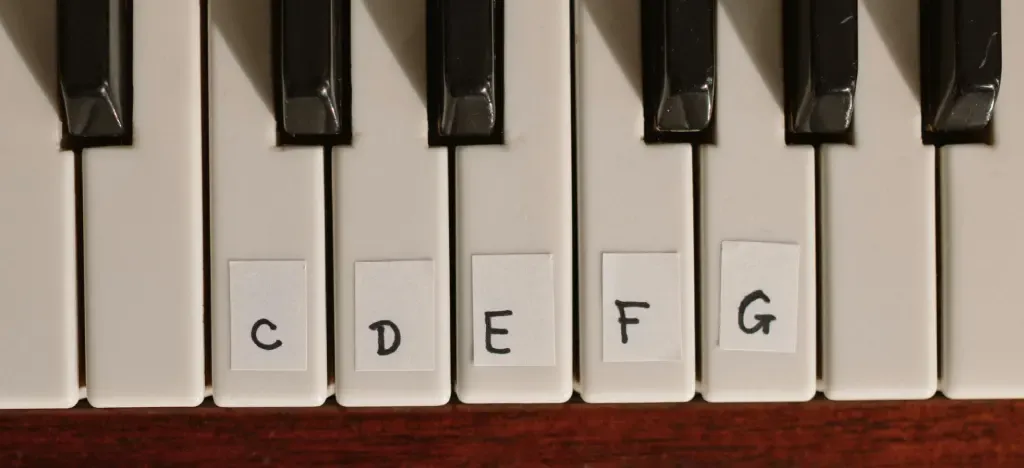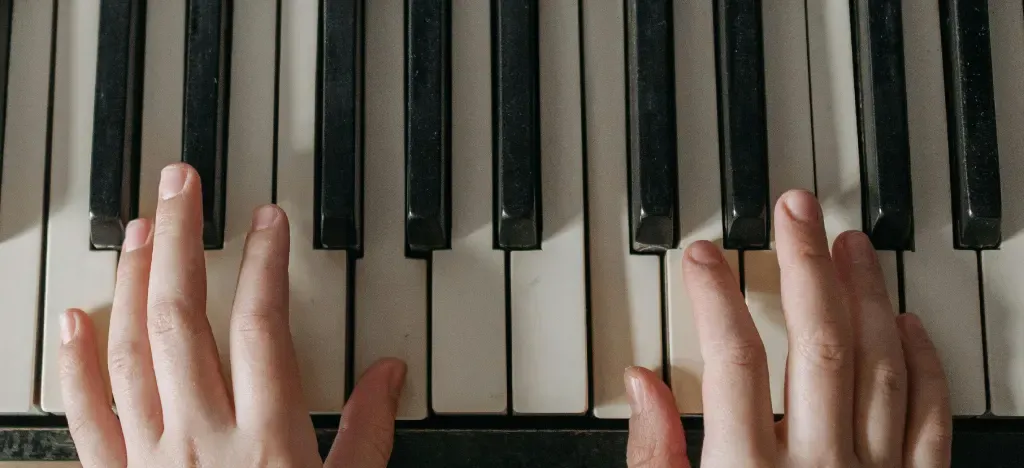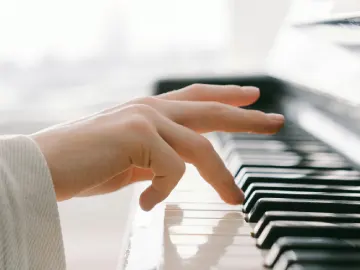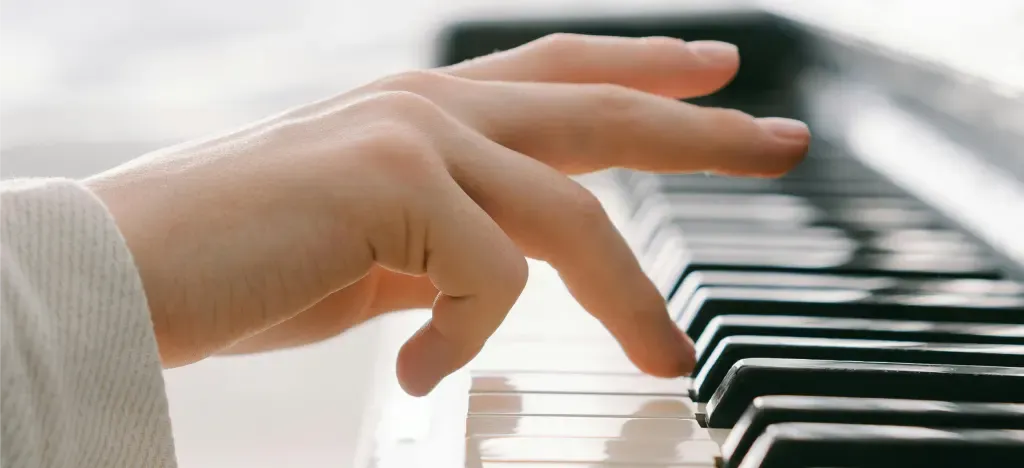Deciding to learn piano is a great step, no matter your age. You might be dreaming of playing your favourite piano songs, composing music, or simply want the therapeutic benefits of playing music. This guide will help you get started from scratch — from learning the piano keys, to playing your first melody, and building confidence with beginner exercises. Plus, you'll get expert piano practice tips and a free video lesson to help you get started the right way!
- Choosing a Piano or Keyboard
- How is a piano keyboard laid out?
- Free video tutorial on identifying piano notes
- Physically labelling your piano keys
- Your first piano melody
- How to lay your hand comfortably on the piano keys
- Simple piano melody using right hand position
- Beginner piano exercises
- Piano practice tips to learn faster
- How long does it take to learn piano?
- Learn beginner piano for free
Choosing a Piano or Keyboard
Before you start learning piano, you'll need to have an instrument. Hopefully, you already have something in front of you, anything with a keyboard will do — maybe an old electronic keyboard, a Midi keyboard plugged into a computer or even an upright piano. Make sure your instrument is set up in a well-lit, comfortable area and that your stool or chair is at the correct height to maintain proper posture.
💡 ARTMASTER TIP: If you're unsure which to choose, check out our guide, including the latest recommendations — Keyboard vs Piano: which should you choose?
How is a piano keyboard laid out?
Piano key names
Fortunately, no matter what type of keyboard you have, all keyboards have the same familiar layout. The piano keyboard consists of a repeating set of white and black keys. In each set, there are:
The piano keyboard consists of a repeating set of white and black keys. In each set, there are:
7 white keys: The notes A to G, then the pattern repeats.
5 black keys: These are sharps (#) and flats (♭), positioned between the white keys.
As you can see, I have highlighted the pattern of white notes C D E F G A. This is because when understanding piano notes, we often use C as a clear visual starting point in the pattern. Plus, the C major scale is a simple place to start as a beginner because it contains just these white notes.
Finding Middle C: Middle C is a key reference point on the keyboard. On an 88-key piano, it is the fourth C key from the left, but on all keyboards it will be roughly in the middle.
Free video tutorial on identifying piano notes
For a clear explanation of the piano notes, watch expert pianist and teacher David Bennett demonstrate it in our free piano tutorial below.
Take your first real step toward playing piano! Join David Bennett’s beginner-friendly course and start playing real songs today. Try it free for 7 days!
Physically labelling your piano keys
 We all learn in a different way, but labelling your piano keys can really help you learn more quickly. Here's a few ways to do it, without damaging your keyboard.
We all learn in a different way, but labelling your piano keys can really help you learn more quickly. Here's a few ways to do it, without damaging your keyboard.
Dry-Erase Markers
Sticky Notes
Colour-coded Dots
Removeable Labels
Whether you label your piano keyboard physically or not, the letters can be used to help you quickly play melodies and chords without having to learn to read piano notation.
Your first piano melody
Piano Letter Notes
What are piano letter notes?
Piano letter notes use the letters A to G to represent the white keys on the piano. This simplified notation helps beginners quickly identify which keys to press without needing to read traditional sheet music.
Reading piano letter notes
Each letter corresponds to a specific key. For example, C is always the white key to the left of the two black keys.
The best place to start is a simple melody that most people recognise: "Twinkle Twinkle Little Star". The melody uses the notes C, D, E, F, G, and A, so first make sure you can find these notes on the keyboard.
For now, play it with any finger you like:
"Twinkle Twinkle Little Star" Melody
Twin-kle twin-kle lit-tle star,
C C G G A A G
How I won-der what you are.
F F E E D D C
Up a - bove the world so high,
G G F F E E D
Like a dia- mond in the sky.
G G F F E E D
Twin-kle twin-kle lit-tle star,
C C G G A A G
How I won-der what you are.
F F E E D D C
Congratulations, you've played your first melody!
Play over it a few times and gradually increase your speed. When you're happy with that, we'll take a brief look at proper hand position on the piano.
💡 ARTMASTER TIP: If you are struggling to keep the rhythm, even the best piano players use a metronome. Find out how in our comprehensive guide — How to practice with a metronome.
How to lay your hand comfortably on the piano keys
 Piano hand posture
Piano hand posture
Here, I think it is worth looking at how to comfortably hold your hands on the keys. This will promote good habits going forward, and make it easier to play piano without straining.
Relax your hands: Let your hands hang loosely and shake them to release any tension.
Curve your fingers: Bring your hands to the keyboard and curve your fingers naturally, as if holding a small ball.
Position your thumbs: Place your thumbs on the middle C key. Keep them straight and relaxed.
Align your fingers: Position your other fingers on the adjacent white keys. For example, with your right thumb on middle C, place your index finger on D, middle finger on E, ring finger on F, and pinky on G.
Maintain a gentle arch: Keep a gentle arch in your fingers and avoid collapsing your knuckles.
Now we will move onto a more challenging melody where you'll be using just your right hand in position and all fingers.
💡 ARTMASTER TIP: Good hand posture will make learning piano easier in the long run!
Simple piano melody using right hand position
"One Love" by Bob Marley
To start playing this famous melody, rest your right thumb on middle C. Play the melody with your right hand in this position: Thumb on C, index finger on D, middle finger on E, ring finger on F, and pinky on G.
The first note of the melody is piano note E - your middle finger. Work your way through the notes slowly and see how you get on.
One love, one heart,
E E D D
Let's get to-ge-ther and feel al-right
F E D C D C E D C
One love, one heart,
E E D D
Give thanks and praise to the Lord
E F F F E D C
And I will feel al-right
C C D E D C
Let's get to-ge-ther and feel al-right
F E D C D C E D CAgain, repeat it a few times and gradually increase your speed as you become more confident. This time, you can concentrate on keeping your hand position as relaxed as possible.
Beginner piano exercises
Especially when you get started on piano, developing good technique is important. Here are a few things beginners can do to improve their skills:
Playing Scales: Scales are sequences of notes played in order, up and down the keyboard. Practising scales helps build finger strength and gets you familiar with the keyboard layout. Start with the C major scale (C-D-E-F-G-A-B-C), then try other major and minor scales.
Chords: Learning piano chords is a must for playing a wide range of songs. Start with basic major and minor chords, the building blocks of many tunes. Practice transitioning smoothly between chords and common chord progressions used in different genres.
Arpeggios: Arpeggios are just broken chords played one note at a time. They improve finger dexterity and hand coordination. Begin with simple arpeggios like the C major arpeggio (C-E-G) and practice them slowly.
💡 ARTMASTER TIP: Find out how to play piano chords.
Piano practice tips to learn faster
Like with all skills, you need to practise, and consistent, regular piano practice can really help improve your skills quickly. It's best to aim for short, frequent practice sessions rather than long, infrequent ones.
Consistent practice: Consistency helps reinforce what you’ve learned and prevents frustration.
Setting goals: Set small, achievable goals for each session, such as learning a new note or playing a song smoothly.
Tracking progress: Keep a practice journal to track your progress and stay motivated.
💡 ARTMASTER TIP: Find out more about the art of effective music practice.
How long does it take to learn piano?
The time it takes depends on consistency:
1 Week – Play simple melodies.
1 Month – Learn basic chords and rhythms.
3-6 Months – Play full songs and understand more complex patterns.
Learn beginner piano for free
This was just a brief introduction, and I hope playing your first melody on piano has given you some inspiration. But if you really want to learn piano, there's no better way than David Bennett's Piano 1 for Beginners course. His course is engaging and fun, and will get you playing some really cool music using piano letter notes.
You can sign up for our FREE 7-day Trial and try it out for free!

